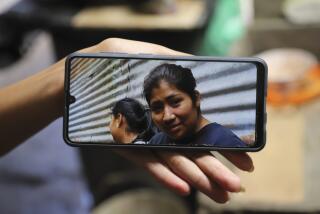Project Rescues Brazil’s Street Children
- Share via
SALVADOR, Brazil — Like thousands of other children and adolescents, 17-year-old Adriana de Souza has a family but for a long time her home was the streets of Salvador, a port city in Brazil’s tropical northeast.
Adriana took drugs, got pregnant at 15 and induced an abortion by taking dangerous medication.
But today Adriana’s life has turned around. She has learned to read and write, has a job and, most important, has returned home to live with her mother.
Adriana is one of the success stories of Projeto Axe, which helps nearly 3,000 of the more than 15,000 street children in Brazil’s third most populous city.
Adriana, who is about to open her first savings account, has a dream: To buy a home someday.
“When I lived on the street I had a dream, which I knew could never come true. Then I was given this opportunity and now I know it can,” said the bubbly teen-ager as she stirred a bowl of steaming soup in the kitchen of a factory belonging to OAS, one of Brazil’s biggest construction companies.
OAS is a major supporter of Projeto Axe and employs 50 16- and 17-year-olds who have gone through the program. This number is expected to rise to 100 this year.
Axe, an African word meaning positive energy, was founded in 1991 by Italian lawyer and philosopher Cesare de Florio la Rocca.
Axe has a philosophy, he said.
“We want children to leave the streets but through the self-realization that the streets are no place for them to be.”
La Rocca has worked with children for 31 years, 26 of them in Brazil. For four years, he served as senior program officer for the U.N. Children’s Fund in Brazil.
With the support of the Italian non-governmental group Terra Nova, La Rocca set out in 1990 to survey Salvador’s street children.
The census found that only 823 children actually slept on the streets but 12,000 lived off the streets, selling candy, washing windshields, begging or stealing.
By 1993 this number had risen to more than 15,000.
One of Axe’s biggest goals is to stimulate the children to return home. La Rocca estimates that only 15% do not have homes or have completely lost touch with their families.
“We do not really need shelters because so many of the children have started to return home. Even though the misery continues and their families are still as big a disgrace as ever, the children create conditions that allow them to more easily accept their families as they are.”
Nilton Silva de Jesus, a 17-year-old who works as an office boy at OAS, used to sell candy on the streets, where he also spent many a night. “My father used to yell at me that I didn’t work, that I only ate. Now he treats me differently,” he said.
In Rio de Janeiro, where last July’s massacre of eight sleeping street children provoked an international outcry, the Inter-American Development Bank is investing in a project similar to Axe.
Like Axe, Projeto Semear seeks to teach street kids and children from very poor families to read and write as well as basic skills needed to gain employment.
Semear, a joint project between the city government and the Catholic archdiocese, has received a three-year donation of $300,000 from the bank, which last year announced an $8-million grant for street children projects in Rio.
Semear offers its 200 students workshops in graphics, sewing, silk-screening and electronics. The children pocket part of the profits they earn making T-shirts and raising chickens.
This is the same method used by Axe, where the children also benefit financially from apprenticeships, even before they are placed in companies such as OAS.
Semear’s students also study agriculture. “It is not so much that we are preparing them to be farmers,” said Alexandre Gollo, one of the teachers. “Rather, it is a sort of therapy.”
The violence and death that pervade the lives of these children has removed all notion of a future.
“These children have always lived for the immediate,” he said. “But with gardening they learn patience.”
More to Read
Sign up for Essential California
The most important California stories and recommendations in your inbox every morning.
You may occasionally receive promotional content from the Los Angeles Times.













